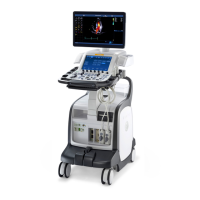General Procedures and Functional Checks
4-28 Vivid E80/E90/E95 – Service Manual
GC091052
Rev. 3
imaging during one or several cardiac cycles with high temporal
resolution.
Using TVI
1. While in 2D mode press TVI on the control panel.
2. Use the trackball (assigned function: Pos) to position the
ROI frame over the area to be examined.
3. Press Select. The instruction Size should be highlighted in
the trackball status bar.
NOTE: If the trackball control Pointer is selected, press Trackball to
be able to select between Position and Size controls.
4. Use the trackball to adjust the dimension of the ROI.
Optimizing TVI
The use of presets gives optimum performance with minimum
adjustment. If necessary, the following controls can be adjusted
to further optimize the TVI display:
NOTE: Refer to ‘Creating presets’ on page 4-8 about creating presets.
• To reduce quantification noise (variance), the Nyquist limit
should be as low as possible, without creating aliasing. To
reduce the Nyquist limit: reduce the Scale value.
NOTE: The Scale value also affects the frame rate. There is a trade
off between the frame rate and quantification noise.
• TVI provides velocity information only in the beam direction.
The apical view typically provides the best window since the
beams are then approximately aligned to the longitudinal
direction of the myocardium (except near the apex). To
obtain radial or circumferential tissue velocities, a
parasternal view must be used. However, from this window
the beam cannot be aligned with the muscle for all the parts
of the ventricle.
NOTE: PW will be optimized for Tissue Velocities when activated
from inside TVI.

